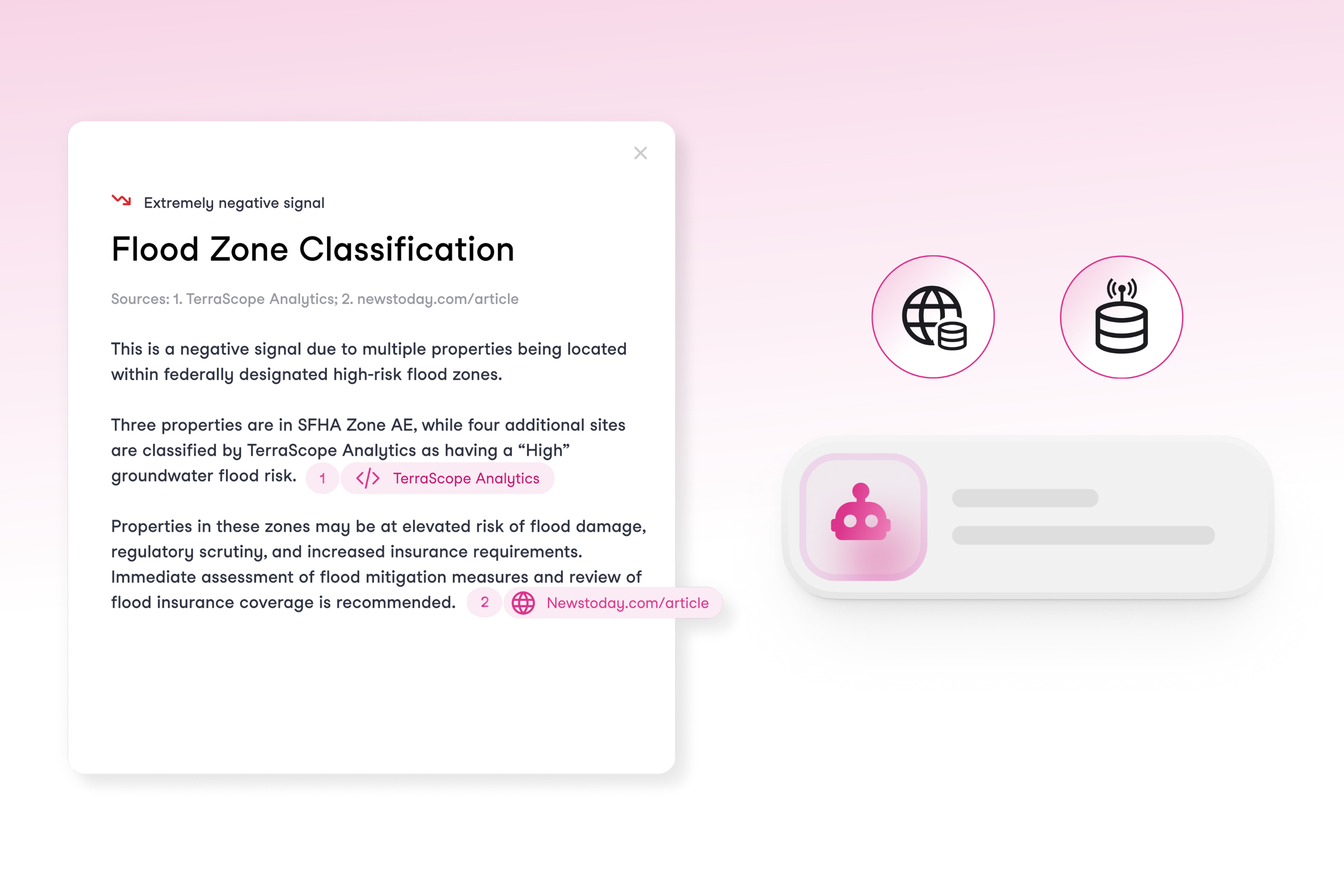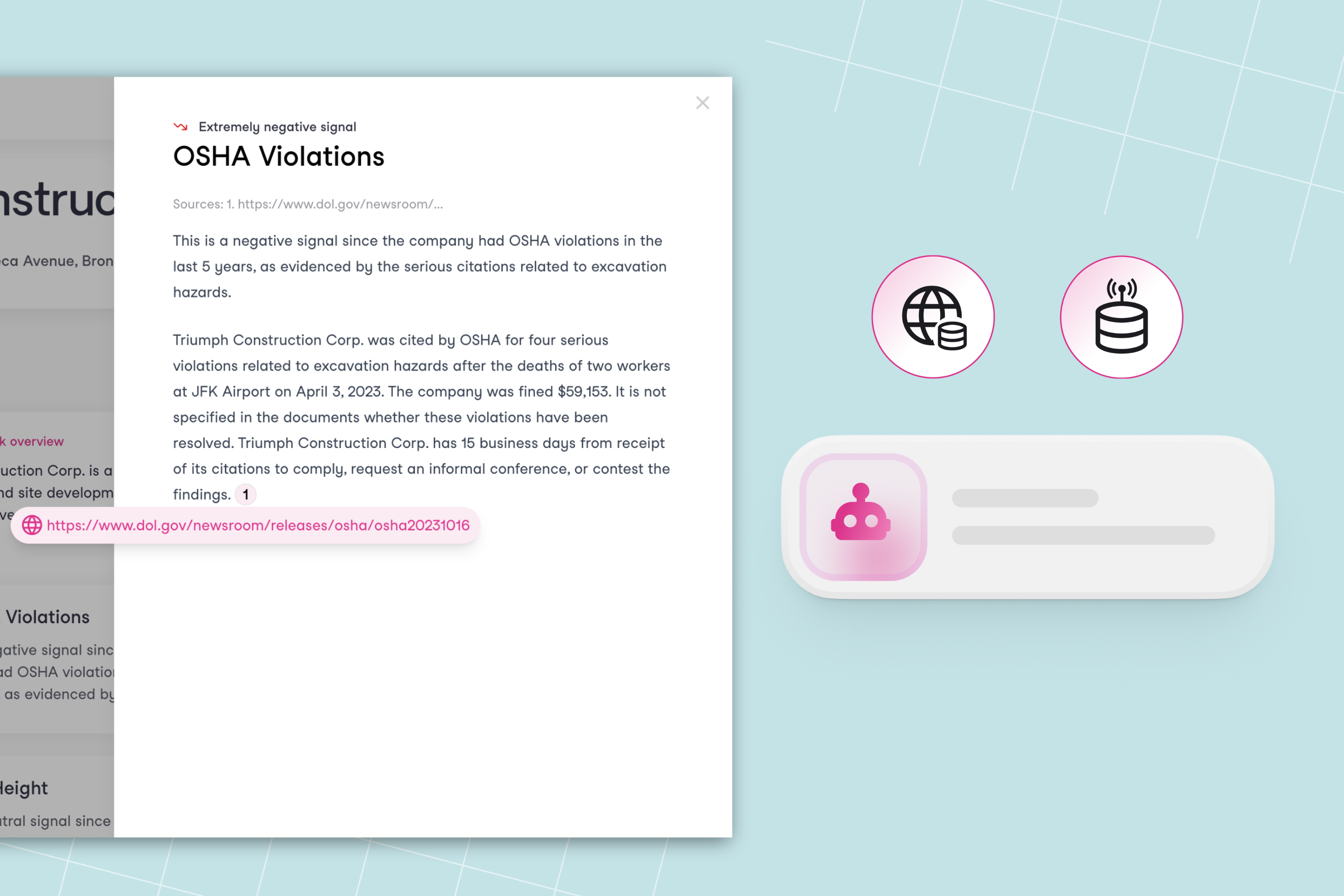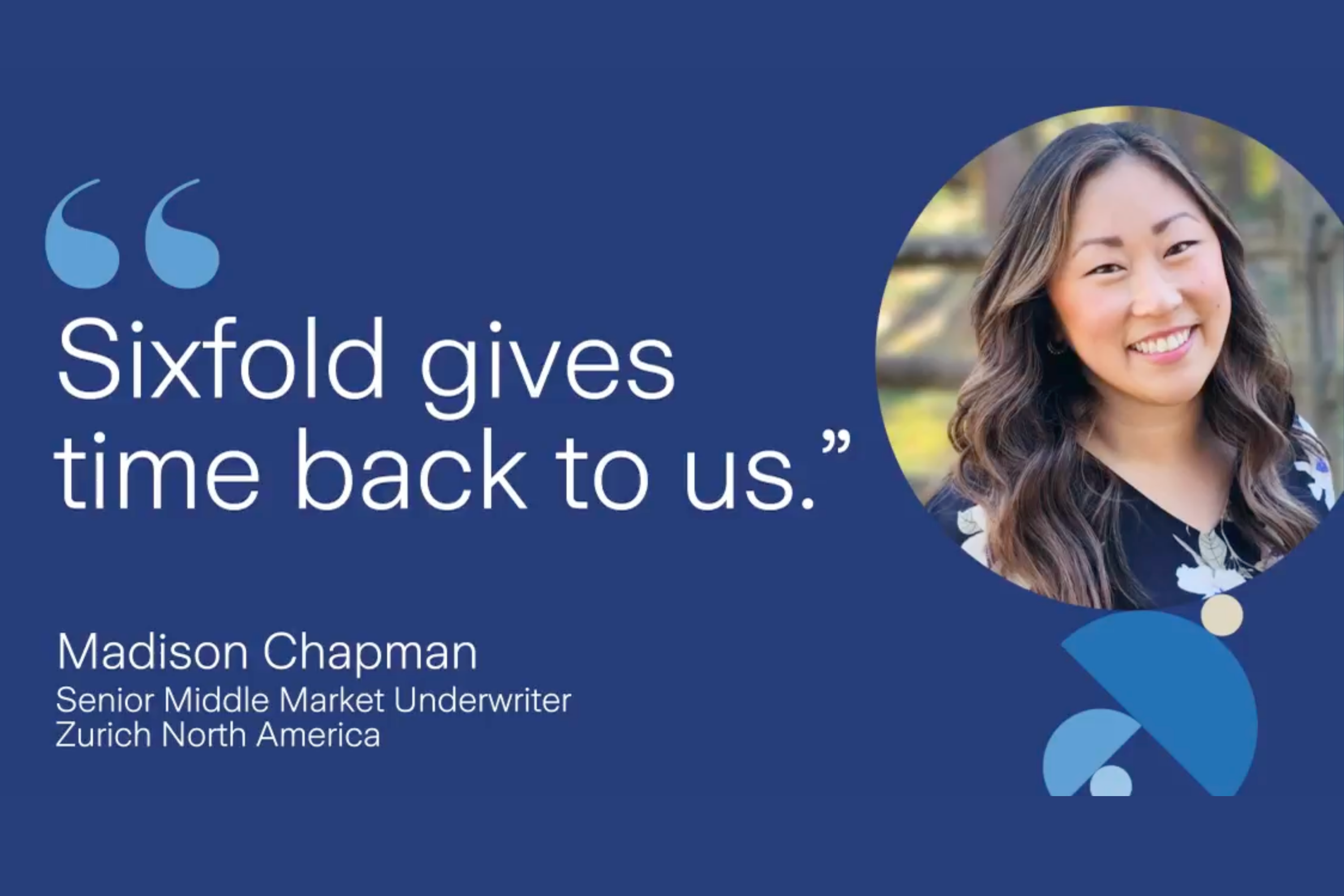

Next-level P&C Insurance Underwriting
Purpose-built AI to enhance efficency, accuracy, and transparency.

Why insurers around the globe choose Sixfold
Zoom in on your best risks
Speeds up intake, helping underwriters focus on submissions that match the insurer's risk appetite.
Consistent UW decisions
Every submission is assessed with the same criteria, making underwriting decisions more precise and consistent.
50% faster risk reviews
Cuts down manual work by instantly gathering and presenting key risk insights, accelerating the risk assessment process.

Captures and applies your unique risk appetite
Securely ingests underwriting guidelines to understand risk preferences
Applies your underwriting rules at scale with full traceability
Easily iterate risk appetite as business needs change

Increase capacity via augmented underwriting
Increases capacity through intelligent submission routing & triaging
Generates risk scores based on alignment with risk appetite
Assign SIC and NAICS codes automatically with full sourcing

Automatically surface what matters most
Automatically surfaces relevant risk factors
Generates plain-language and contextual summaries
Ingests data from disparate sources (applicant data, third-party, and proprietary)



Your compliance
team ❤️ Sixfold
Hallucination controls: Real data, trusted results.
Data privacy: Your data is your data, we help you keep it that way.
Full traceability: Our AI models fully source findings and conclusions.


Curious to explore some more?
.png)
Referral Agent: From “To-Do” to “Done” in Seconds
Sixfold is shifting from insight to action. Our AI has helped underwriters surface risks, highlight insights, and guide decisions, but now we’re taking the next step with a suite of agents designed to clear bottlenecks in the underwriting process. First up: Referral Agent.
Since AI’s introduction in underwriting, it has been about surfacing information: flagging risks, highlighting important insights, and providing recommendations. But there's always been a gap between AI that knows what needs to be done and AI that actually does it.
Sixfold is building AI agents that close that gap: agents that work alongside underwriters to move cases forward autonomously. Referral Agent marks a shift in what Sixfold can do for your underwriting team, starting with one of the biggest bottlenecks we hear about from underwriters: referrals.
“We’re no longer just telling underwriters what to do; we’re helping them do it. This launch represents a major shift in how we drive efficiency and consistency in underwriting — turning “here's what you need to know’ into “here’s what we’ve already done about it”. The Referral Agent is just the beginning of that vision.”
- Alex Schmelkin, Founder and CEO of Sixfold
Where 40% of Cases Get Stuck
When we asked underwriters about their biggest workflow frustrations, referrals came up again and again.
Every underwriter knows this routine: you spot a case that needs escalation, and suddenly you're building a package. Pull the rules. Cross-reference submission details. Write a detailed email explaining your reasoning. Make sure the approver, such as senior underwriter, has everything they need to make a decision.
It's necessary work, but it takes about an hour per case. With up to 40% of applications requiring escalation, underwriters can spend half their day packaging referrals instead of evaluating risk.
The ripple effects hurt everyone. Brokers wait days for responses while referrals sit in approval queues. Approvers get packages missing key details and have to circle back with questions. What should be a quick handoff becomes a multi-day process that slows everyone down.
AI That Completes the Loop
Referral Agent transforms how this process works. Instead of stopping at identification that a case needs referral, it handles the next steps as well. It executes referrals on its own: flags when a case needs escalation, assembles the complete referral package and drafts a ready-to-send email in your preferred tone.
The underwriter's role changes from package preparation to package review, freeing up time from admin work and letting them focus on more strategic decisions.
The repetitive process that used to take 60 minutes? It now takes 1 minute.
How it works
.png)
Sixfold knows the insurer’s unique risk appetite, applies what it’s learned, and clearly shows if and why a referral is required after case analysis is completed.
When the agent flags a case for escalation, it constructs a complete referral package in email form: a business summary including the company's operational focus and a structured rationale section that walks through each referral guideline breach step-by-step, citing the exact percentages, dollar amounts, and policy thresholds that might have triggered the referral requirement.
With this launch, we’re making the underwriter’s inbox part of the workflow. Underwriters can just forward a broker’s email, with attachments, straight to Sixfold, and the risk assessment kicks off automatically. When it’s time to refer, a pre-drafted email is done, ready to be sent with a single click from the underwriter’s default email provider.
Benefits by Role
.png)
For Referrers
- Always know when to refer
- No more repetitive referral tasks
- Hours back every day for actual underwriting
For Approvers
- Every referral is standardized, making it easier to review
- With complete referral packages, you can decide faster - often same-day
- Automatic audit trail for compliance and training
For Insurers
- Referral guidelines are applied consistently across every team
- Quotes out faster → happier brokers → improved hit ratios
- A process that scales with every underwriter hired
The Broader Vision
Referral Agent is part of a shift in what Sixfold can do for your team. In 2024, Sixfold gave underwriters a brain that reads and assesses; now Sixfold equips them with a brain that acts: AI agents that move cases forward on their own.
Each Sixfold agent plugs into your existing workflow to solve a specific bottleneck. Backlog of referrals? Deploy Referral Agent. Team spending hours researching online? The Research Agent does it in minutes. Endless broker negotiations slowing you down? The Negotiation Agent (coming soon) handles it. Use them individually or stack them together,
“Every underwriter knows that sinking feeling of a growing referral queue. With the Referral Agent, that queue clears itself. It proves that AI can take action, not just give advice. It's the first of many agents that free underwriters from processor work so they can become portfolio strategists."
- Lana Jovanovic, Head of Product @Sixfold
Experience It Live: Try Referral Agent at ITC Vegas in October. Forward an email, watch the risk assessment run, and generate a referral in real time. Book your ITC meeting with Sixfold, or schedule a digital demo.

Research Agent: From Hours of Digging to Seconds of Insights
Meet Research Agent, underwriters’ new research partner. It spots the gaps in a submission, finds the missing details, and delivers the insights that matter most for the decision.
In commercial underwriting, submissions rarely contain everything underwriters need to properly assess risks. Critical information such as SEC filings, cyber incidents, litigation history, or executive misconduct aren't in the application, and finding that data falls on the underwriter.
The stakes are high: miss one key detail, and underwriters are suddenly pricing a completely different risk. The research to uncover this information means hours going through public sources such as news archives and databases.
All while brokers demand quotes fast in an increasingly competitive market.
Why We Built it
With Research Agent, underwriters have a research partner who finds the gaps in the submission, locates the missing pieces, and brings back the insights that matter for the decision. The agent does the external research work on the underwriter’s behalf.
By filling critical information gaps and applying research from the public web and connected third-party data sources into Sixfold’s overall risk assessment, underwriters are given a complete risk picture for more precise appraisal. Underwriters can view the exact origin of any piece of information, with clickable links that take them directly to the original source for verification or further detail.
The result? Quotes go out faster, underwriters make more consistent calls, and decisions get made without wondering what might have been missed.
“Research Agent has been one of our most anticipated features, especially for customers in specialty lines where extensive research is needed to get a complete picture of the risk. We expect the agent to save them at least two hours per case.”
- Alex Schmelkin, Founder & CEO at Sixfold
When Research Makes Or Breaks The Quote
Sixfold’s Research Agent is designed to support commercial lines of business where external data is essential in risk evaluation and quoting. Lines of business we’re seeing the highest demand for include:
- General Liability - Public web research to capture OSHA violations, litigation history, and negative press coverage.
- Cyber - 3rd party cyber threat intelligence plus broader public web research for cyber breach disclosures and corporate litigation involving cybersecurity lapses.
- E&S Property - Public and/or 3rd party data on location and climate based risks (flood, wildfire, crime, etc.), permit history, and company mentions in the news.
- Directors & Officers (D&O) - News on executive misconduct, class-action lawsuits, SEC filings, and shareholder news.
- Healthcare & Life Sciences - Public records of malpractice lawsuits, regulatory actions, patient safety concerns, and news coverage related to clinical trials or product safety.
While Competitors Prep, You Price
Research Agent delivers wins across the board, immediate time savings for underwriters and competitive advantages insurers.
“We’re seeing growing demand for research-heavy underwriting. With this launch, we accelerate the time to quote while elevating decision-making with richer context.”
- Lana Jovanovic, Head of Product at Sixfold
Focus on what matters: Those hours gained back per case? That's time underwriters can spend on what they do best: making smart risk decisions, strengthening broker relationships, and building customer connections instead of drowning in research tasks.
Speed wins deals: Reduced manual research burden means underwriters can respond faster to brokers, increase their quote volume, and capture more bound premiums. For carriers competing on both responsiveness and quality, this means winning more of the right business.
Same quality, every time: Every underwriter now has access to the same thorough research process. No more inconsistency based on who's handling the case or how much time they have to dig. Better decisions, whether it's one case or a thousand.
Improved portfolio performance: Sixfold’s comprehensive risk assessment, now with the added capability of public web research and connected third-party data, equips underwriters with a deeper understanding of each risk.
Contact Sixfold to see the Research Agent in action.

Sixfold Expands Underwriting Brain: AI to Research, Reason & Document
Over the past 2+ years, we've built an AI underwriting brain that evaluates risk based on each insurer's specific risk appetite. Now we're expanding its capabilities with agentic research that provides better insights, case notes that connects patterns, and documentation that's actionable and audit-ready.
Over the past 2+ years, we've built an AI underwriting brain that evaluates risk based on each insurer's specific risk appetite, helping underwriters get better quotes out the door, faster.
Now we're expanding our capabilities with agentic research that provides deeper insights, intelligent risk synthesis that connects important patterns, and documentation that's actionable and audit-ready.
The result? Underwriting teams can operate at the speed their business demands, with the consistency and scale they need to stay competitive.
Underwriting AI: From Nice-to-Have to Business Critical
Commercial underwriting faces increasing complexity: rising costs from inflation and litigation, escalating risks from natural disasters and geopolitical instability, and mounting pressure from clients.
Meanwhile, 93% of business leaders believe companies that successfully deploy AI agents in the next 12 months will outpace their competitors¹. BCG identifies underwriting as the function where carriers will see the most measurable AI impact. The reason is clear: commercial underwriters spend hours daily on research, documentation, and repetitive tasks that AI handles expertly.
"Ask any underwriter how they spend their time, and they'll tell you: research and documentation.
Sixfold now cuts through those two major components so teams can get back to the work that matters: making decisions, nurturing broker relationships, and building their portfolio."
- Lana Jovanovic, Head of Product at Sixfold
What’s New?
Research Agent: Agentic Detective for Hidden Risk Data

In commercial underwriting, submissions rarely contain everything underwriters need to properly assess risks. Critical information such as SEC filings, cyber incidents, litigation history, or executive misconduct aren't in the application, and finding that data falls on the underwriter.
The Research Agent does the external research work on the underwriter’s behalf. By filling critical information gaps and applying research from the public web and connected third-party data sources into Sixfold’s overall risk assessment, underwriters are given a complete risk picture for more precise appraisal.
The impact? Saving underwriters at least 2 hours per submission which means faster replies to brokers, increased quote volume, and more bound premiums.
Learn more about Research Agent here.
Narrative: Instant Case Notes That Fit Your Standards
Manual documentation drains productivity and invites inconsistency. With Narrative, Sixfold automatically generates case documentation aligned to your risk appetite, use case, and preferred format, whether for quoting, referrals, audits, or compliance.
The impact? Underwriters get clear, structured summaries to act on (and an average of 60 minutes time saved per case) and insurers gain consistent, audit-ready documentation.
Read more about Narrative, including the benefits the Zurich North America team has already seen.
Deep Thinker: The Heavy Lifter for Complex Risk
Risk assessment isn’t just about data, it’s about understanding. Deep Thinker enhances Sixfold’s core risk assessment brain with a specialized AI model designed for complex reasoning, numerical calculations and trend analysis, and deeper operational considerations.
The impact? Delivers more accurate and precise risk signals.
For example, Deep Thinker can flag concerning cybersecurity practices such as a company's outdated SSL certificates, accurately calculate key metrics such as a 30% rise in phishing claims, and explain its rationale and calculations in plain language. Feeding nuanced facts into the underwriting brain for risk signaling.
"These features hit every major pain point that underwriters deal with on a daily basis: manual research, inconsistent documentation, and complex risk analysis. Instead of spending hours on these tasks, Sixfold delivers it in minutes."
- Laurence Brouillette, Head of Customers & Partnerships at Sixfold
Benefits for Underwriters & Insurers

Get quotes out the door faster: Insurers typically average 8 days from submission to quote3—Sixfold can turn that into hours, helping carriers beat out competitors and win more business.
Standardization built right in: 70% of insurers cite inconsistent underwriting decisions as a core problem4. The combined power of Sixfold’s AI risk assessment, advanced risk appetite, and automated case documentation ensure consistent, scalable (and audit-ready!) underwriting across individuals and teams.
Moving beyond the back office: By eliminating manual research and documentation tasks, Sixfold gives underwriters more quoting capacity, plus the time and mental bandwidth back for thoughtful judgements, broker relationships, and portfolio building.
To learn how Sixfold can help your underwriting team scale, schedule a demo.
Sixfold plays nicely with your existing underwriting tools.

